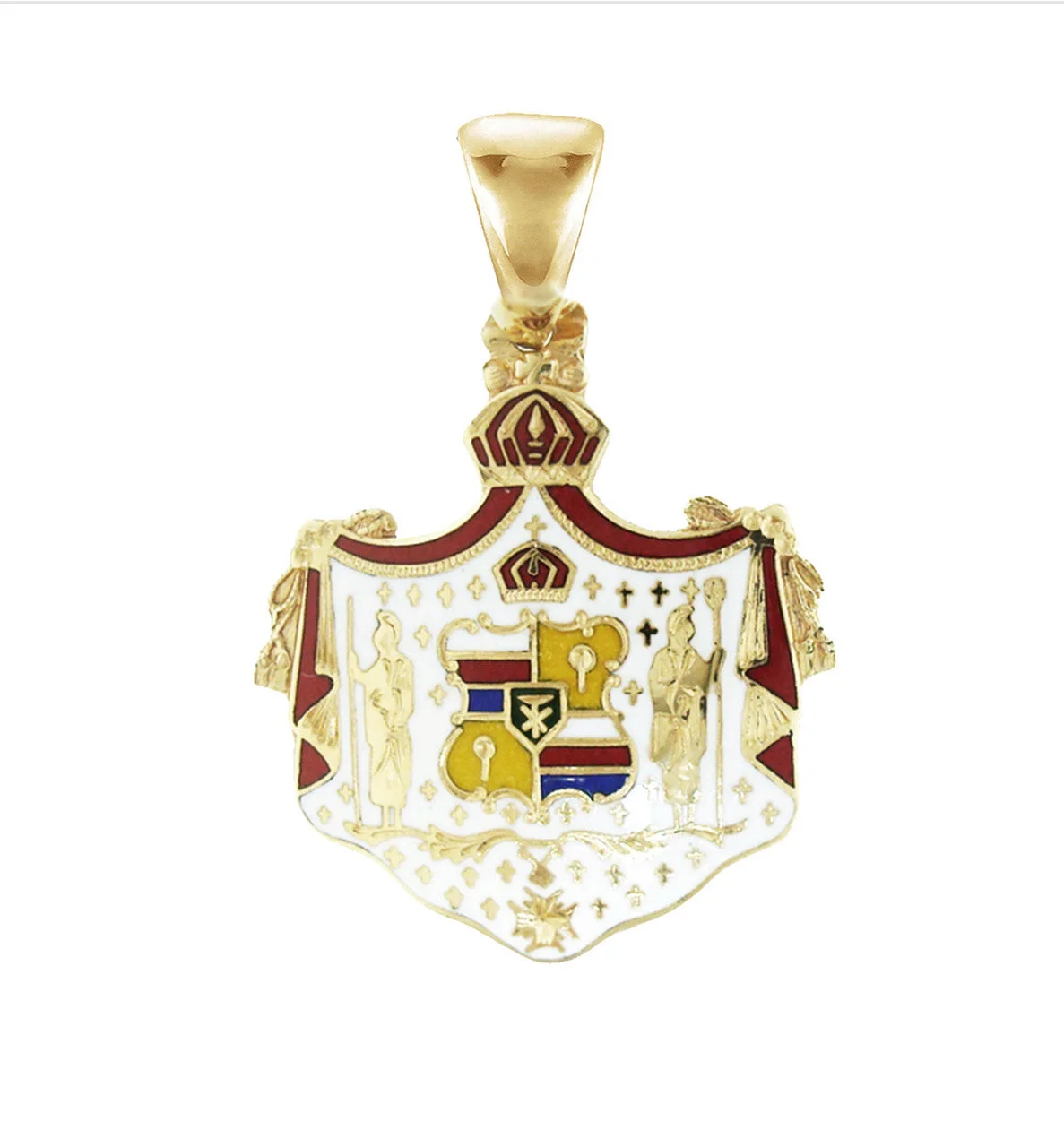
14k Hawaiian Coat of Arms (White Enamel)
King Kamehameha III drafted the first constitution of Hawai’i in 1840. The Hawaiian Coat of Arms came into existence by Rev. William Richards and Timoteo Ha’alilio.
The shield was also considered from the bearer’s point of view or position. In medieval times a knight’s shield right side is his “Dexter” side in heraldic terms. His left side is his “Sinister” side. The dexter side could also represent one’s paternal ancestry and first born child. The sinister side represents the maternal lines.
The quartered shield bears red, white and blue stripes. This is because they represent the eight inhabited islands. Two pulo’ulo’u (sacred kapu sticks) warn commoners of the sacred areas where the ancient ali’i resided. They are on a yellow field representing the royal color of chief capes.
Another important element is the green flag named “puela” (An ancient flag atop the mast of chief double-hulled canoes). This “puela” rested on a diagonal cross of two “hoe” (canoe paddles). They lay on a field of green.
The external ornaments of the design have a draped “ahu’ula” (feathered cape). Most prominent are the crown and two supporters. They are Kame’eiamoku, and Kamanawa. The twins are uncles and trusted advisors to Kamehameha the Great.
Kame’eiamoku holds the Kahili or feathered staff and Kamanawa holds the ‘ihe” or spear. The ornamented crown contains eight “kalo” (taro leaves). It represents the eight inhabited islands.
The Hawaiian Coat of Arms stands today as a symbol of pride, unity, and joy. As a result, the Native Hawaiian community is stronger. Consequently, the symbols take a new meaning with each generation. As a result, they tie old and new generations together.
Ref: https://hawaiianatart.org/featured/hawaiian-coat-of-arms/
Dimentions of crest not including bail.
- Medium = 22mm x 25mm
**chain not included.
King Kamehameha III drafted the first constitution of Hawai’i in 1840. The Hawaiian Coat of Arms came into existence by Rev. William Richards and Timoteo Ha’alilio.
The shield was also considered from the bearer’s point of view or position. In medieval times a knight’s shield right side is his “Dexter” side in heraldic terms. His left side is his “Sinister” side. The dexter side could also represent one’s paternal ancestry and first born child. The sinister side represents the maternal lines.
The quartered shield bears red, white and blue stripes. This is because they represent the eight inhabited islands. Two pulo’ulo’u (sacred kapu sticks) warn commoners of the sacred areas where the ancient ali’i resided. They are on a yellow field representing the royal color of chief capes.
Another important element is the green flag named “puela” (An ancient flag atop the mast of chief double-hulled canoes). This “puela” rested on a diagonal cross of two “hoe” (canoe paddles). They lay on a field of green.
The external ornaments of the design have a draped “ahu’ula” (feathered cape). Most prominent are the crown and two supporters. They are Kame’eiamoku, and Kamanawa. The twins are uncles and trusted advisors to Kamehameha the Great.
Kame’eiamoku holds the Kahili or feathered staff and Kamanawa holds the ‘ihe” or spear. The ornamented crown contains eight “kalo” (taro leaves). It represents the eight inhabited islands.
The Hawaiian Coat of Arms stands today as a symbol of pride, unity, and joy. As a result, the Native Hawaiian community is stronger. Consequently, the symbols take a new meaning with each generation. As a result, they tie old and new generations together.
Ref: https://hawaiianatart.org/featured/hawaiian-coat-of-arms/
Dimentions of crest not including bail.
- Medium = 22mm x 25mm
**chain not included.